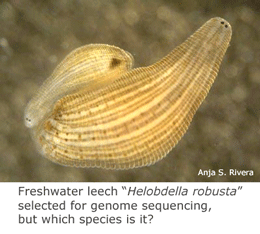Relying on morphologic species descriptions lacking DNA sequences is like diagnosing patients without laboratory tests. An experienced clinician can often make the correct diagnosis from examination alone, but laboratory tests are frequently needed to confirm or point to other causes. Many advances in medicine reflect incorporating laboratory testing into routine evaluation. Two papers on leeches suggest similar benefits to taxonomy from incorporating mtDNA analysis into routine practice.
 In May 2005 Conservation Genetics 6:467 researchers at the American Museum of Natural History analyze morphology, mitochondrial COI, and nuclear ND-I sequences of genus Helobdella leeches from Austrialia, New Zealand, South Africa, Hawaii, and South America. The tale starts with a leech discovered in Germany in 1985, H. striata, re-named H. europaea in 1987.
In May 2005 Conservation Genetics 6:467 researchers at the American Museum of Natural History analyze morphology, mitochondrial COI, and nuclear ND-I sequences of genus Helobdella leeches from Austrialia, New Zealand, South Africa, Hawaii, and South America. The tale starts with a leech discovered in Germany in 1985, H. striata, re-named H. europaea in 1987.
Authors Siddall and Budinoff found that H. europaea is morphologically and genetically indistinguishable from a leech “discovered” in Australia in 1998, H. papillornata. Including COI sequences in initial species descriptions would have prevented wasted taxonomic effort, and a species native to South America would probably not be given the unfortunate name europaea.
In December 2006 Evol Devel 8:491, scientists from University of Maryland and University of California, Berkeley, apply COI barcoding to another Helobdella leech, H. robusta, a model organism in developmental biology and one of the lucky species selected for genome sequencing. Researchers Bely and Weisblat obtained leech specimens from laboratory cultures and field sites. They found that isolates thought to be H. robusta actually represent four species, 2 of which co-exist at the same locality. The authors observe “the perils of misidentification and taxonomic confusion in the lab are numerous and costly” and conclude with a call for routine application of DNA barcoding and collection of voucher specimens to confirm identity of laboratory organisms.